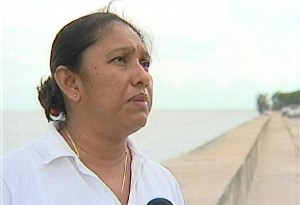Hands Across the Sand in solidarity with ban on oil concessions
While the NTUCB, B.T.I.A., COLA, and other coalition members prepare for discussions with government, they are also continuing their outreach and education campaign with the public. This weekend lobster festivals will be celebrated in Placencia and Caye Caulker. But in addition to the festivities, the Coalition to Save Our Natural Heritage is also planning a show of unity called Hands Across the Sand. OCEANA’s Vice President for Belize and coalition member, Audrey Shepherd explained how the activity will show support for the cause.
Audrey Matura Shepherd, VP, OCEANA Belize
“This weekend, there is a program called Hands Across the Sand. It’s an international program we are organizing in Belize. San Pedro is doing their own, Caye Caulker and Placencia. And what that means, at twelve midday, no matter where you are in the world, twelve o’clock your time you are to stand on your beach and for fifteen minutes join hands as a symbol that you are against offshore drilling. So we’re inviting everybody who is going to the Lobster fest in Caye Caulker to join us there and we’re also inviting people. San Pedro they are organizing their own and Placencia. It’s just symbolism. If it’s only ten people, we don’t mind. People need to stand up and let the government and world know that our barrier reef, our marine resources will not be drilled in.”
Jose Sanchez
“The coalition seems to have all the key players that can bring about change. Do you think we will see the foot marches associated with some of the groups?”
Audrey Matura Shepherd
“That will happen if the government doesn’t listen to us. That is definitely not one of the things that is out. This is our public awareness part of campaign and we’re making sure we do it. But we also know that we’ve written to the Prime Minister, we’ve written to the Minister of Natural Resources, the Minister of Tourism and the Minister of Fisheries because we need to go to the table and speak to them because we’re prepared to be diplomatic as well while we continue our public awareness campaign. We have at least gotten an acknowledgement from the Prime Minister about our request and he has asked us to meet with the Minister of Natural Resources. We are in the process of negotiating which date is convenient for both of us. in the meantime, we are also preparing our presentation on the different issues so that they know the immediate issues and our proposed solutions because it’s not as though we are only criticizing. We have proposed solutions but they will only know that if they sit at the table with us and speak to us about everything that we see from the people’s perspective.”
San Pedro will also be joining the Hands Across the Sand activity on Saturday.


We the Peoples National Party (PNP) will not be at the beach since at that time we will be at Yaxche watershed fair in Golden stream but we will be holding hands to show solidarity.
Wil Maheia
Leader
Peoples National Party
672-9999
From June 21st New York Times article:
“Norwegian company Det Norske Veritas found 11 cases where crews on deepwater rigs had lost control of wells and then activated blowout preventers to prevent a spill. In only 6 of those cases were the wells brought under control, leading the researchers to conclude that in actual practice, blowout preventers used by deepwater rigs had a failure rate of 45%.”
In two studies , in 2002 and 2004, one of the oil industries premier authorities on blowout preventers, West Engineering Services of Brookshire, Texas, found a more basic problem: even when everything worked right, some blind shear rams still FAILED to cut pipe.
West’s experts concluded that calculations used by makers of blowout preventers overestimated the cutting ability of blind shear rams. (the blades that are pushed together with hydraulics to pinch pipes shut and stop oil leaks like the one in the Gulf).
Modern drill pipe is nearly twice as strong as older pipes of the same size. In addition, the intense pressure and frigid temperatures of new deep water drilling make it tougher to shear/cut a drilling pipe. These and other “additive pressures” the researchers found, can demand HUNDREDS OF THOUSANDS of pounds of extra cutting force that blowout preventers being used now cannot produce.
The team examined 14 new rigs, they found that 7 were not even checked to see shear rams would work in DEEP water. Of the remaining 7 only THREE were found to be able to shear pipe at their maximum rated water depths.
This non-functional drilling equipment is likely not only used in the U.S., but also worldwide in the deep sea oil drilling industry. As we all know these multinationals oil companies operate worldwide and often standardize their drilling equipment. (use the same equipment worldwide).
There is much more damming information in this article and it is worth reading for the statistics and facts concerning deep sea oil drilling, the title of the article is: “Between Blast and Spill, One last, Flawed Hope”—New York Times, Monday June 21st, Page A1.